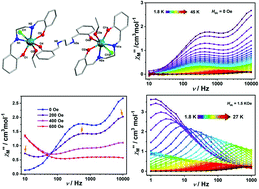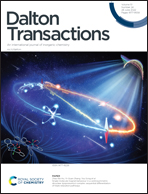Single-molecule magnet behaviour in a centrosymmetric dinuclear dysprosium(iii) complex: sequential differentiation of triple relaxation pathways†
Abstract
A dinuclear complex with the formula Dy2L2(H2L)Cl2(EtOH)2 (Dy2) has been synthesized by reacting DyCl3·H2O with a ligand H2L (H2L = N,N′-ethylenebis(salicylideneimine)) using ethanol as the solvent. Its crystal structure can be viewed as a dimer of two Dy(III) fragments, where each Dy(III) site shows a N2O6Cl coordination sphere with a pentagonal bipyramid geometry (D5h). Magnetic measurements reveal that Dy2 behaves as a single-ion magnet (SIM) under a zero field. When the field is applied, the ac magnetic susceptibilities show double and triple peaks under high (≥600 Oe) and low (<600 Oe) dc fields, respectively. In contrast to the common double relaxation pathways in SIMs, such multiple and intricate relaxation pathways have not been reported yet in the previous literature. In this work, by experimental analysis of the ac signals, we attribute the three slow relaxation pathways to quantum tunnelling of magnetization (QTM), intermolecular dipole–dipole interaction and spin reversal, respectively. In addition, ab initio calculations are used to elucidate the magnetic behaviours of Dy2. Overall, our work indicates that the interpretation of the relaxation process using double relaxation pathways is incomplete and difficult in previously reported literature.

- This article is part of the themed collection: Dalton turns 50 – celebrating our board members past and present


 Please wait while we load your content...
Please wait while we load your content...